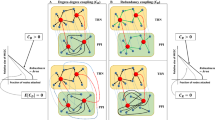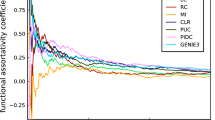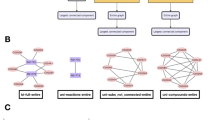Abstract
Biological interaction networks have been in the scientific limelight for nearly a decade. Increasingly, the concept of network biology and its various applications are becoming more commonplace in the community. Recent years have seen networks move from pretty pictures with limited application to solid concepts that are increasingly used to understand the fundamentals of biology. They are no longer merely results of postgenome analysis projects, but are now the starting point of many of the most exciting new scientific developments. We discuss here recent progress in identifying and understanding interaction networks, new tools that use them in predictive ways in exciting areas of biology, and how they have become the focus of many efforts to study, design and tinker with biological systems, with applications in biomedicine, bioengineering, ecology and beyond.
This is a preview of subscription content, access via your institution
Access options
Subscribe to this journal
Receive 12 print issues and online access
$259.00 per year
only $21.58 per issue
Buy this article
- Purchase on Springer Link
- Instant access to full article PDF
Prices may be subject to local taxes which are calculated during checkout



Similar content being viewed by others
References
Oliver, S.G. et al. The complete DNA sequence of yeast chromosome III. Nature 357, 38–46 (1992).
Fields, S. & Song, O. A novel genetic system to detect protein-protein interactions. Nature 340, 245–246 (1989).
Rigaut, G. et al. A generic protein purification method for protein complex characterization and proteome exploration. Nat. Biotechnol. 17, 1030–1032 (1999).
Eyckerman, S. et al. Reverse MAPPIT: screening for protein-protein interaction modifiers in mammalian cells. Nat. Methods 2, 427–433 (2005).
Paumi, C.M. et al. Mapping protein-protein interactions for the yeast ABC transporter Ycf1p by integrated split-ubiquitin membrane yeast two-hybrid analysis. Mol. Cell 26, 15–25 (2007).
Uetz, P. et al. A comprehensive analysis of protein-protein interactions in Saccharomyces cerevisiae. Nature 403, 623–627 (2000).
Ito, T. et al. A comprehensive two-hybrid analysis to explore the yeast protein interactome. Proc. Natl. Acad. Sci. USA 98, 4569–4574 (2001).
Gavin, A.C. et al. Proteome survey reveals modularity of the yeast cell machinery. Nature 440, 631–636 (2006).
Krogan, N.J. et al. Global landscape of protein complexes in the yeast Saccharomyces cerevisiae. Nature 440, 637–643 (2006).
Giot, L. et al. A protein interaction map of Drosophila melanogaster. Science 302, 1727–1736 (2003).
Li, S. et al. A map of the interactome network of the metazoan C. elegans. Science 303, 540–543 (2004).
Rual, J.F. et al. Towards a proteome-scale map of the human protein-protein interaction network. Nature 437, 1173–1178 (2005).
Stelzl, U. et al. A human protein-protein interaction network: a resource for annotating the proteome. Cell 122, 957–968 (2005).
Collins, S.R. et al. Toward a comprehensive atlas of the physical interactome of Saccharomyces cerevisiae. Mol. Cell. Proteomics 6, 439–450 (2007).
Rual, J.F. et al. Human ORFeome version 1.1: a platform for reverse proteomics. Genome Res. 14, 2128–2135 (2004).
Wei, C. et al. Closing in on the C. elegans ORFeome by cloning TWINSCAN predictions. Genome Res. 15, 577–582 (2005).
Li, Q.R. et al. Revisiting the Saccharomyces cerevisiae predicted ORFeome. Genome Res. 18, 1294–1303 (2008).
Vidalain, P.O., Boxem, M., Ge, H., Li, S. & Vidal, M. Increasing specificity in high-throughput yeast two-hybrid experiments. Methods 32, 363–370 (2004).
Mahrus, S. et al. Global sequencing of proteolytic cleavage sites in apoptosis by specific labeling of protein N termini. Cell 134, 866–876 (2008).
Yu, H. et al. High-quality binary protein interaction map of the yeast interactome network. Science, published online, doi:10.1126/science.1158684 (21 August 2008).
Stein, A. & Aloy, P. A molecular interpretation of genetic interactions in yeast. FEBS Lett. 582, 1245–1250 (2008).
Pawson, T. & Linding, R. Synthetic modular systems–reverse engineering of signal transduction. FEBS Lett. 579, 1808–1814 (2005).
Bushell, K.M., Sollner, C., Schuster-Boeckler, B., Bateman, A. & Wright, G.J. Large-scale screening for novel low-affinity extracellular protein interactions. Genome Res. 18, 622–630 (2008).
Gisler, S.M. et al. Monitoring protein-protein interactions between the mammalian integral membrane transporters and PDZ-interacting partners using a modified split-ubiquitin membrane yeast two-hybrid system. Mol. Cell Proteomics 7, 1362–1377 (2008).
Vazquez, M.E., Nitz, M., Stehn, J., Yaffe, M.B. & Imperiali, B. Fluorescent caged phosphoserine peptides as probes to investigate phosphorylation-dependent protein associations. J. Am. Chem. Soc. 125, 10150–10151 (2003).
Linding, R. et al. Systematic discovery of in vivo phosphorylation networks. Cell 129, 1415–1426 (2007).
Aloy, P. Shaping the future of interactome networks. Genome Biol. 8, 316 (2007).
Berger, M.F. & Bulyk, M.L. Protein binding microarrays (PBMs) for rapid, high-throughput characterization of the sequence specificities of DNA binding proteins. Methods Mol. Biol. 338, 245–260 (2006).
Warner, J.B. et al. Systematic identification of mammalian regulatory motifs' target genes and functions. Nat. Methods 5, 347–353 (2008).
Mukhopadhyay, A., Deplancke, B., Walhout, A.J. & Tissenbaum, H.A. Chromatin immunoprecipitation (ChIP) coupled to detection by quantitative real-time PCR to study transcription factor binding to DNA in Caenorhabditis elegans. Nat. Protoc. 3, 698–709 (2008).
Vetter, D. Chemical microarrays, fragment diversity, label-free imaging by plasmon resonance–a chemical genomics approach. J. Cell. Biochem. Suppl. 39, 79–84 (2002).
Pearson, H. Meet the human metabolome. Nature 446, 8 (2007).
Orchard, S. et al. The minimum information required for reporting a molecular interaction experiment (MIMIx). Nat. Biotechnol. 25, 894–898 (2007).
Kanehisa, M. et al. KEGG for linking genomes to life and the environment. Nucleic Acids Res. 36, D480–D484 (2008).
Borneman, A.R. et al. Target hub proteins serve as master regulators of development in yeast. Genes Dev. 20, 435–448 (2006).
Barabasi, A.L. & Albert, R. Emergence of scaling in random networks. Science 286, 509–512 (1999).
Albert, R., Jeong, H. & Barabasi, A.L. Error and attack tolerance of complex networks. Nature 406, 378–382 (2000).
Wolf, Y.I., Karev, G. & Koonin, E.V. Scale-free networks in biology: new insights into the fundamentals of evolution? Bioessays 24, 105–109 (2002).
Jeong, H., Mason, S.P., Barabasi, A.L. & Oltvai, Z.N. Lethality and centrality in protein networks. Nature 411, 41–42 (2001).
Pache, R., Babu, M. & Aloy, P. Exploiting gene deletion fitness effects in yeast to understand the modular architecture of protein complexes under different growth conditions. PLoS Comput. Biol. (in the press).
Aloy, P. & Russell, R.B. Structural systems biology: modelling protein interactions. Nat. Rev. Mol. Cell Biol. 7, 188–197 (2006).
Jansen, R. et al. A Bayesian networks approach for predicting protein-protein interactions from genomic data. Science 302, 449–453 (2003).
Mani, K.M. et al. A systems biology approach to prediction of oncogenes and molecular perturbation targets in B-cell lymphomas. Mol. Syst. Biol. 4, 169 (2008).
Pujana, M.A. et al. Network modeling links breast cancer susceptibility and centrosome dysfunction. Nat. Genet. 39, 1338–1349 (2007).
Chuang, H.Y., Lee, E., Liu, Y.T., Lee, D. & Ideker, T. Network-based classification of breast cancer metastasis. Mol. Syst. Biol. 3, 140 (2007).
Pazos, F., Juan, D., Izarzugaza, J.M., Leon, E. & Valencia, A. Prediction of protein interaction based on similarity of phylogenetic trees. Methods Mol. Biol. 484, 523–535 (2008).
Juan, D., Pazos, F. & Valencia, A. High-confidence prediction of global interactomes based on genome-wide coevolutionary networks. Proc. Natl. Acad. Sci. USA 105, 934–939 (2008).
Borneman, A.R. et al. Divergence of transcription factor binding sites across related yeast species. Science 317, 815–819 (2007).
Papageorgiou, A.C. & Wikman, L.E. Is JAK3 a new drug target for immunomodulation-based therapies? Trends Pharmacol. Sci. 25, 558–562 (2004).
Johnson, Z. et al. Chemokine inhibition–why, when, where, which and how? Biochem. Soc. Trans. 32, 366–377 (2004).
Wells, J.A. & McClendon, C.L. Reaching for high-hanging fruit in drug discovery at protein-protein interfaces. Nature 450, 1001–1009 (2007).
Neduva, V. & Russell, R.B. Peptides mediating interaction networks: new leads at last. Curr. Opin. Biotechnol. 17, 465–471 (2006).
Rix, U. et al. Chemical proteomic profiles of the BCR-ABL inhibitors imatinib, nilotinib, and dasatinib reveal novel kinase and nonkinase targets. Blood 110, 4055–4063 (2007).
Adrian, F.J. et al. Allosteric inhibitors of Bcr-abl-dependent cell proliferation. Nat. Chem. Biol. 2, 95–102 (2006).
Oltersdorf, T. et al. An inhibitor of Bcl-2 family proteins induces regression of solid tumours. Nature 435, 677–681 (2005).
Vassilev, L.T. et al. In vivo activation of the p53 pathway by small-molecule antagonists of MDM2. Science 303, 844–848 (2004).
Moerke, N.J. et al. Small-molecule inhibition of the interaction between the translation initiation factors eIF4E and eIF4G. Cell 128, 257–267 (2007).
He, M.M. et al. Small-molecule inhibition of TNF-alpha. Science 310, 1022–1025 (2005).
Braisted, A.C. et al. Discovery of a potent small molecule IL-2 inhibitor through fragment assembly. J. Am. Chem. Soc. 125, 3714–3715 (2003).
Jhoti, H., Cleasby, A., Verdonk, M. & Williams, G. Fragment-based screening using X-ray crystallography and NMR spectroscopy. Curr. Opin. Chem. Biol. 11, 485–493 (2007).
Neumann, T., Junker, H.D., Schmidt, K. & Sekul, R. SPR-based fragment screening: advantages and applications. Curr. Top. Med. Chem. 7, 1630–1642 (2007).
Neduva, V. et al. Systematic discovery of new recognition peptides mediating protein interaction networks. PLoS Biol. 3, e405 (2005).
Edwards, R.J. et al. Bioinformatic discovery of novel bioactive peptides. Nat. Chem. Biol. 3, 108–112 (2007).
Stein, A. & Aloy, P. Contextual specificity in peptide-mediated protein interactions. PLoS ONE 3, e2524 (2008).
van der Greef, J. & McBurney, R.N. Innovation: rescuing drug discovery: in vivo systems pathology and systems pharmacology. Nat. Rev. Drug Discov. 4, 961–967 (2005).
Apic, G., Ignjatovic, T., Boyer, S. & Russell, R.B. Illuminating drug discovery with biological pathways. FEBS Lett. 579, 1872–1877 (2005).
Xu, J.J. et al. Cellular imaging predictions of clinical drug-induced liver injury. Toxicol. Sci. 105, 97–105 (2008).
Saez-Rodriguez, J. et al. Flexible informatics for linking experimental data to mathematical models via DataRail. Bioinformatics 24, 840–847 (2008).
Kuhn, M., von Mering, C., Campillos, M., Jensen, L.J. & Bork, P. STITCH: interaction networks of chemicals and proteins. Nucleic Acids Res. 36, D684–D688 (2008).
Borisy, A.A. et al. Systematic discovery of multicomponent therapeutics. Proc. Natl. Acad. Sci. USA 100, 7977–7982 (2003).
Lee, M.S. et al. The novel combination of chlorpromazine and pentamidine exerts synergistic antiproliferative effects through dual mitotic action. Cancer Res. 67, 11359–11367 (2007).
Lehár, J. et al. Chemical combination effects predict connectivity in biological systems. Mol. Syst. Biol. 3, 80 (2007).
Zimmermann, G.R., Lehar, J. & Keith, C.T. Multi-target therapeutics: when the whole is greater than the sum of the parts. Drug Discov. Today 12, 34–42 (2007).
Lindsay, M.A. Finding new drug targets in the 21st century. Drug Discov. Today 10, 1683–1687 (2005).
Altschul, S.F. et al. Gapped BLAST and PSI-BLAST: a new generation of protein database search programs. Nucleic Acids Res. 25, 3389–3402 (1997).
Matilla-Dueñas, A. The highly heterogeneous spinocerebellar ataxias: from genes to targets for therapeutic intervention. Cerebellum 7, 97–100 (2008).
Suthram, S., Sittler, T. & Ideker, T. The Plasmodium protein network diverges from those of other eukaryotes. Nature 438, 108–112 (2005).
Kelley, B.P. et al. Conserved pathways within bacteria and yeast as revealed by global protein network alignment. Proc. Natl. Acad. Sci. USA 100, 11394–11399 (2003).
Koyutürk, M. et al. Pairwise alignment of protein interaction networks. J. Comput. Biol. 13, 182–199 (2006).
Flannick, J., Novak, A., Srinivasan, B.S., McAdams, H.H. & Batzoglou, S. Graemlin: general and robust alignment of multiple large interaction networks. Genome Res. 16, 1169–1181 (2006).
Sharan, R. & Ideker, T. Modeling cellular machinery through biological network comparison. Nat. Biotechnol. 24, 427–433 (2006).
Kiemer, L. & Cesareni, G. Comparative interactomics: comparing apples and pears? Trends Biotechnol. 25, 448–454 (2007).
Pawson, T. Organization of cell-regulatory systems through modular-protein-interaction domains. Philos. Transact. A Math Phys. Eng. Sci. 361, 1251–1262 (2003).
Kashtan, N. & Alon, U. Spontaneous evolution of modularity and network motifs. Proc. Natl. Acad. Sci. USA 102, 13773–13778 (2005).
Yeh, B.J. & Lim, W.A. Synthetic biology: lessons from the history of synthetic organic chemistry. Nat. Chem. Biol. 3, 521–525 (2007).
Bashor, C.J., Helman, N.C., Yan, S. & Lim, W.A. Using engineered scaffold interactions to reshape MAP kinase pathway signaling dynamics. Science 319, 1539–1543 (2008).
Yokobayashi, Y., Weiss, R. & Arnold, F.H. Directed evolution of a genetic circuit. Proc. Natl. Acad. Sci. USA 99, 16587–16591 (2002).
Ro, D.K. et al. Production of the antimalarial drug precursor artemisinic acid in engineered yeast. Nature 440, 940–943 (2006).
Keasling, J.D. & Chou, H. Metabolic engineering delivers next-generation biofuels. Nat. Biotechnol. 26, 298–299 (2008).
Atsumi, S., Hanai, T. & Liao, J.C. Non-fermentative pathways for synthesis of branched-chain higher alcohols as biofuels. Nature 451, 86–89 (2008).
de Lorenzo, V. Blueprint of an oil-eating bacterium. Nat. Biotechnol. 24, 952–953 (2006).
Gómez, M.J., Pazos, F., Guijarro, F.J., de Lorenzo, V. & Valencia, A. The environmental fate of organic pollutants through the global microbial metabolism. Mol. Syst. Biol. 3, 114 (2007).
Steinmetz, L.M. et al. Systematic screen for human disease genes in yeast. Nat. Genet. 31, 400–404 (2002).
Isalan, M. et al. Evolvability and hierarchy in rewired bacterial gene networks. Nature 452, 840–845 (2008).
Basu, S., Gerchman, Y., Collins, C.H., Arnold, F.H. & Weiss, R. A synthetic multicellular system for programmed pattern formation. Nature 434, 1130–1134 (2005).
Chen, M.T. & Weiss, R. Artificial cell-cell communication in yeast Saccharomyces cerevisiae using signaling elements from Arabidopsis thaliana. Nat. Biotechnol. 23, 1551–1555 (2005).
Bulter, T. et al. Design of artificial cell-cell communication using gene and metabolic networks. Proc. Natl. Acad. Sci. USA 101, 2299–2304 (2004).
Isalan, M., Lemerle, C. & Serrano, L. Engineering gene networks to emulate Drosophila embryonic pattern formation. PLoS Biol. 3, e64 (2005).
Acknowledgements
We thank the Institute for Research in Biomedicine (IRB Barcelona) and the Banco Bilbao Vizcaya Argentaria Foundation (BBVA Foundation) for organizing the Barcelona Biomed Conference “Targeting and Tinkering with Interaction Networks.” We also thank R. Weiss (Princeton University) for providing the images for Figure 3 and A. Zanzoni (IRB Barcelona) for help with Figure 1. P.A. acknowledges the financial support received from the Spanish Ministerio de Educación y Ciencia through the grants PSE-010000-2007-1 and BIO2007-62426. We are both supported by the grant 3D-Repertoire from the European Commission under FP6 contract LSHG-CT-2005-512028.
Author information
Authors and Affiliations
Corresponding authors
Rights and permissions
About this article
Cite this article
Russell, R., Aloy, P. Targeting and tinkering with interaction networks. Nat Chem Biol 4, 666–673 (2008). https://doi.org/10.1038/nchembio.119
Published:
Issue Date:
DOI: https://doi.org/10.1038/nchembio.119
This article is cited by
-
How the evolution of multicellularity set the stage for cancer
British Journal of Cancer (2018)
-
Proteome-wide alterations on adipose tissue from obese patients as age-, diabetes- and gender-specific hallmarks
Scientific Reports (2016)
-
Prediction of Protein–Protein Interaction Sites with Machine-Learning-Based Data-Cleaning and Post-Filtering Procedures
The Journal of Membrane Biology (2016)
-
A chemo-centric view of human health and disease
Nature Communications (2014)
-
Interactome3D: adding structural details to protein networks
Nature Methods (2013)



